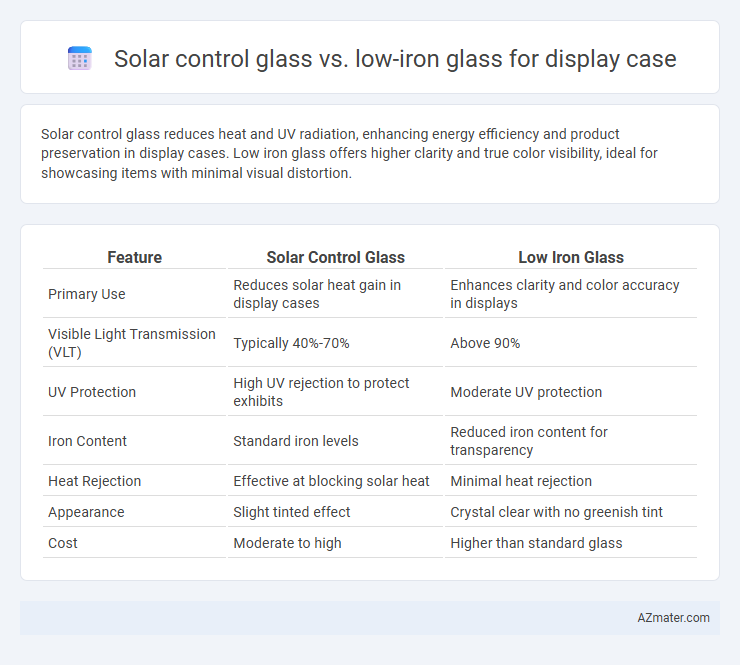Solar control glass reduces heat and UV radiation, enhancing energy efficiency and product preservation in display cases. Low iron glass offers higher clarity and true color visibility, ideal for showcasing items with minimal visual distortion.
Table of Comparison
| Feature | Solar Control Glass | Low Iron Glass |
|---|---|---|
| Primary Use | Reduces solar heat gain in display cases | Enhances clarity and color accuracy in displays |
| Visible Light Transmission (VLT) | Typically 40%-70% | Above 90% |
| UV Protection | High UV rejection to protect exhibits | Moderate UV protection |
| Iron Content | Standard iron levels | Reduced iron content for transparency |
| Heat Rejection | Effective at blocking solar heat | Minimal heat rejection |
| Appearance | Slight tinted effect | Crystal clear with no greenish tint |
| Cost | Moderate to high | Higher than standard glass |
Introduction to Display Case Glass Options
Solar control glass for display cases offers superior UV protection and heat rejection, enhancing energy efficiency and preventing product fading. Low iron glass provides higher clarity and true color rendition, ideal for showcasing items with minimal distortion. Choosing between solar control and low iron glass depends on balancing thermal performance with optical clarity for optimal display presentation.
What is Solar Control Glass?
Solar control glass is specially designed to reduce solar heat gain by reflecting and absorbing a significant portion of the sun's infrared radiation, making it ideal for display cases that require temperature regulation and UV protection. Unlike low iron glass, which enhances clarity and light transmission by minimizing iron content, solar control glass prioritizes energy efficiency and glare reduction while maintaining visibility of displayed items. This advanced glass technology helps preserve sensitive products in display cases by maintaining a stable internal climate and preventing fading caused by UV exposure.
What is Low Iron Glass?
Low iron glass is a type of ultra-clear glass with significantly reduced iron content, enhancing its transparency and light transmission compared to standard clear glass. This makes it ideal for display cases where color accuracy and clarity are critical, allowing products to be seen without the greenish tint typically caused by iron impurities. In contrast, solar control glass incorporates coatings that reduce heat and UV light transmission, prioritizing energy efficiency but sometimes compromising clarity and color fidelity.
Key Differences: Solar Control vs Low Iron Glass
Solar control glass significantly reduces solar heat gain and glare in display cases by filtering infrared and ultraviolet rays, enhancing energy efficiency and product preservation. Low iron glass offers superior clarity and light transmission with minimal greenish tint, ideal for showcasing items with true color accuracy. The key difference lies in solar control glass prioritizing thermal insulation and glare reduction, while low iron glass emphasizes optical clarity and color fidelity.
Light Transmission and Display Clarity
Solar control glass for display cases offers lower light transmission, typically ranging from 30% to 70%, which reduces glare and protects exhibits from UV damage without significantly compromising visibility. In contrast, low iron glass provides higher light transmission, often above 90%, delivering superior display clarity and true color representation by minimizing the greenish tint present in standard glass. Selecting solar control glass balances light filtration and UV protection, while low iron glass prioritizes maximum transparency and visual accuracy for premium display presentation.
UV Protection and Artifact Preservation
Solar control glass significantly reduces harmful UV radiation, offering superior protection for artifacts in display cases by minimizing fading and material degradation. Low iron glass, while providing enhanced clarity and color accuracy due to its reduced iron content, offers less UV blocking capability, making it less effective for long-term preservation. Choosing solar control glass ensures optimal UV protection crucial for safeguarding sensitive and valuable artifacts from light damage.
Energy Efficiency Considerations
Solar control glass reduces heat gain by reflecting infrared radiation, significantly lowering cooling costs in display cases exposed to direct sunlight. Low iron glass offers higher visible light transmittance and enhanced clarity but allows more solar heat, potentially increasing energy consumption for temperature regulation. Choosing solar control glass optimizes energy efficiency by balancing natural light with superior thermal performance in display environments.
Durability and Maintenance Requirements
Solar control glass offers enhanced durability due to its ability to resist UV radiation and thermal stress, reducing the risk of glass degradation and fading over time in display cases. Low iron glass provides superior clarity and aesthetic appeal but may require more frequent cleaning and careful maintenance to prevent surface scratches and water spotting. Selecting solar control glass minimizes maintenance needs and extends the lifespan of display cases in environments with high sunlight exposure.
Cost Comparison and ROI
Solar control glass typically has a higher upfront cost compared to low iron glass due to its advanced coatings that reduce heat gain and improve energy efficiency in display cases. Investing in solar control glass can lead to a faster return on investment (ROI) by lowering cooling costs and preserving merchandise quality, making it more cost-effective over time despite the initial price difference. Low iron glass offers a lower initial cost and enhanced clarity but lacks energy-saving benefits, which may result in higher operational expenses and a slower ROI for display case applications.
Best Applications: Choosing the Right Glass for Your Display Case
Solar control glass is ideal for display cases in environments exposed to high sunlight, as it reduces heat gain and protects exhibits from UV damage, maintaining optimal temperature and preserving sensitive items. Low iron glass offers superior clarity and true color visibility, making it the best choice for showcasing products that require pristine visual presentation, such as jewelry or art pieces. Selecting between solar control and low iron glass depends on whether thermal protection or visual brilliance is the primary requirement for the display case.

Infographic: Solar control glass vs Low iron glass for Display case
 azmater.com
azmater.com